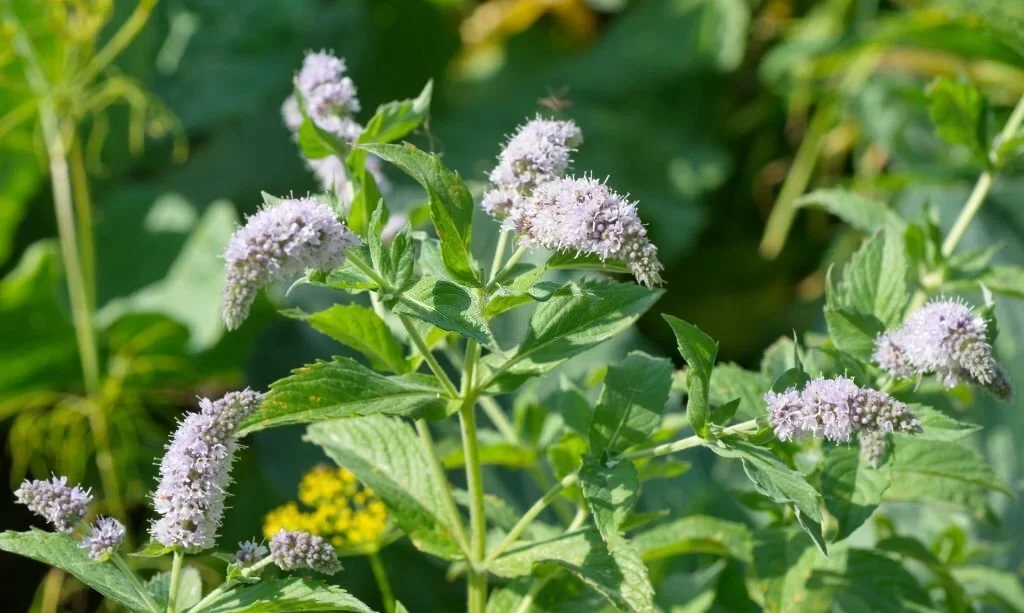Mint, with its fresh and aromatic leaves, is a beloved herb in gardens and kitchens around the world. Whether used in teas, cocktails, salads, or as a garnish, mint adds a burst of flavor and fragrance to countless dishes. Yet, as any gardener knows, mint has a story that extends beyond its culinary uses. It’s a story that unfolds through growth, transformation, and the emergence of delicate blossoms. In this article, we’ll delve into the intriguing world of mint flowering. We’ll explore the growth stages of mint plants, from their humble beginnings as tiny seeds or cuttings to their lush maturity. We’ll also demystify the mint flowering process, shedding light on the factors that trigger these aromatic herbs to burst forth in colorful blooms. Whether you’re a seasoned gardener or a novice, understanding the journey of mint from seedling to flower will deepen your appreciation for this versatile herb and help you make the most of its unique attributes.
- Easy to grow
- Aromatic leaves
- Garden use: Herb garden & containers
- Culinary use: Teas & other beverages, salads, garnish, jelly, desserts
- Plant in full sun to partial shade for the best yields
The Growth Stages of Mint
To truly appreciate the beauty of mint flowering, one must first understand the remarkable growth stages of these perennial herbs. The journey of mint begins with the planting of seeds or the nurturing of cuttings. In their infancy, mint seedlings are delicate and tender, requiring careful attention to sunlight, watering, and soil conditions. As they establish their roots and grow their first sets of leaves, mint plants enter the juvenile phase. This is a period of rapid growth when the plants become hardier and more resilient, forming lush, green foliage that exudes the signature minty aroma.
With time, mint plants reach maturity, a stage marked by full, bushy growth. At this point, they are ready to be harvested and enjoyed in a variety of culinary creations. However, this journey is far from over. Mint’s perennial nature means that it continues to flourish year after year, with new growth sprouting from established roots. This remarkable cycle allows for a continuous supply of fresh mint leaves, making it a staple in many herb gardens.
The Mint Flowering Process
The transition from a thriving mint plant to one adorned with delicate blossoms is a fascinating process. The mint flowering process is not solely determined by age but is influenced by a combination of environmental factors. These factors include day length, temperature, and the specific mint variety. As mint plants mature, they begin to develop flower buds at the tips of their stems.
The emergence of these tiny flower buds heralds the onset of the mint flowering phase. Depending on the variety and growing conditions, this can happen at various points in the plant’s life. Some mint varieties are more prone to early flowering, while others may delay their blossoms until later in the season.
Intriguingly, the act of flowering can alter the flavor profile of mint leaves. The transition often leads to a shift from sweet and mild flavors to more intense and slightly bitter notes. This change in taste can impact how you use mint in culinary applications, as flowering leaves may lend a unique flavor dimension to your dishes.
Understanding the growth stages and flowering process of mint is the first step to unlocking its full potential in your garden and kitchen. As we delve deeper into the world of mint, we’ll explore the appearance of mint flowers, their impact on flavor, and practical tips for managing mint flowering to maintain the best of both worlds – delightful leaves and captivating blooms.
Appearance and Characteristics of Mint Flowers
The emergence of mint flowers transforms these herbs into stunning botanical wonders. Mint flowers typically appear in clusters or spikes, creating visually striking patterns. They can be found in various colors, including shades of white, pink, purple, and lavender, depending on the mint variety. The petals of mint flowers often form a tubular shape with a distinct upper lip and a lower lip, resembling tiny orchids.
One of the distinctive features of mint flowers is their arrangement in whorls or verticillasters, where multiple flower clusters grow in tiers along the stem. These floral arrangements contribute to the elegant and aesthetic appeal of mint plants when in full bloom.
Mint flowers also attract pollinators, such as bees and butterflies, with their nectar-rich blooms. As pollinators visit the flowers, they aid in the reproduction of mint plants, promoting their continued growth and vitality.
Impact on Flavor and Culinary Use
While the appearance of mint flowers is captivating, their emergence often comes with a notable change in the flavor of the leaves. As mint plants divert their energy toward flowering and seed production, the leaves may experience a flavor shift. They tend to become more intense, with a slightly bitter edge, compared to the milder, sweeter taste of non-flowering leaves.
This flavor transformation can influence the culinary use of mint. Some chefs and culinary enthusiasts appreciate the unique taste of flowering mint leaves and choose to incorporate them into specific dishes. For example, the slightly bitter notes of flowering mint can add depth to salads, sauces, or desserts, providing a nuanced and aromatic flavor profile.
However, it’s important to note that the culinary preference for mint leaves varies among individuals. Some may prefer the milder taste of non-flowering leaves for traditional uses like mint tea or classic cocktails. The impact on flavor is a testament to the versatility of mint, offering a range of taste options for various culinary creations.
Managing Mint Flowering
Gardeners and cooks alike may wonder how to manage mint flowering to maintain the desired flavor of their mint leaves. Fortunately, there are several strategies to consider:
- Regular Pruning: Pruning mint plants by snipping off the flowering stems can encourage the plant to redirect its energy toward leaf production. Frequent pruning throughout the growing season can help preserve the milder flavor of the leaves.
- Pinching Off Flower Buds: When you notice the development of flower buds, you can pinch them off before they fully bloom. This prevents the plant from entering full flowering mode and can extend the period of milder-tasting leaves.
- Maintaining Ideal Growing Conditions: Providing mint plants with optimal growing conditions, including adequate sunlight, well-draining soil, and consistent moisture, can support vigorous leaf growth and potentially delay the onset of flowering.
- Choosing Non-Flowering Shoots: When harvesting mint for culinary use, select non-flowering shoots for the freshest and mildest flavor. These young, tender leaves are ideal for mint tea, garnishes, or any dish where you prefer a milder mint taste.
Understanding the impact of mint flowering on flavor and implementing these management techniques allows you to enjoy the best of both worlds – the captivating beauty of mint flowers and the versatile flavor of its leaves. By adapting your approach to the specific needs of your mint plants, you can savor their culinary potential throughout the growing season.
Harvesting Mint Flowers
Harvesting mint flowers is a delightful and rewarding part of cultivating these aromatic herbs. As the mint plants bloom, you’ll want to gather the blossoms at their peak to capture their beauty and flavor. To harvest mint flowers:
- Choose a sunny morning when the dew has dried, as this is when the essential oils in the flowers are most concentrated.
- Gently snip the flower clusters from the plant using clean, sharp scissors or pruning shears. Leave a small portion of stem attached to the flowers for easy handling.
- Collect the harvested flowers in a basket or container, being mindful not to crush or bruise them, as this can release their fragrant oils prematurely.
Mint flowers can be used in various culinary creations, including salads, desserts, and beverages. They make for visually stunning garnishes and add a unique flavor profile to your dishes.
Perennial Growth and Propagation
Mint’s perennial nature is a gardener’s delight, as it means that mint plants continue to thrive year after year. Even after the flowering phase, when the plant’s energy is focused on producing seeds, mint will bounce back with fresh growth. This resilience allows you to enjoy a continuous supply of mint leaves without the need for replanting.
To propagate mint, consider these methods:
- Cuttings: Taking cuttings from established mint plants and rooting them in soil or water is a simple way to create new plants. Once the cuttings develop roots, they can be transplanted into pots or the garden.
- Division: Divide mature mint plants every few years to rejuvenate them and prevent overcrowding. Carefully separate the root mass into smaller sections and replant them in separate locations.
- Self-Seeding: Mint is known for its ability to self-seed. Be prepared for new mint seedlings to emerge near the parent plant. You can transplant these seedlings to other areas of your garden or share them with fellow gardeners.
Preventing Mint from Becoming Invasive
While the perennial nature of mint is advantageous, it’s important to be aware that mint has a reputation for spreading vigorously and potentially becoming invasive if left unchecked. To prevent mint from overtaking your garden:
- Containment: Planting mint in containers or pots can effectively limit its spread. This method is especially useful if you want to keep mint from encroaching on other garden plants.
- Barriers: Installing barriers, such as buried plastic or metal edging, can create underground walls that restrict the lateral growth of mint runners.
- Regular Pruning: Consistent pruning not only encourages healthy leaf production but also helps control the size and spread of mint plants.
- Harvesting: Frequent harvesting of mint leaves and flowers naturally manages the growth of the plant, as it redirects energy away from vegetative expansion.
Conclusion
Mint’s journey from seed or cutting to flowering plant is a captivating cycle that gardeners and culinary enthusiasts can appreciate. Understanding the stages of mint growth and the flowering process empowers you to make the most of this versatile herb. Harvesting mint flowers adds a creative dimension to your culinary endeavors, while the perennial nature of mint ensures a consistent supply of fresh leaves.
Remember that the impact of mint flowering on flavor can be both a challenge and an opportunity in the kitchen. By adopting proactive management techniques, such as pruning and selecting non-flowering shoots, you can enjoy the best of both worlds – the alluring beauty of mint flowers and the delightful flavor of its leaves.
Mint, with its resilience and diverse uses, continues to enchant gardeners and chefs alike. Whether you’re growing it in a garden bed, container, or on your windowsill, mint’s journey from seed to flower is a testament to the enduring charm of this aromatic herb.




